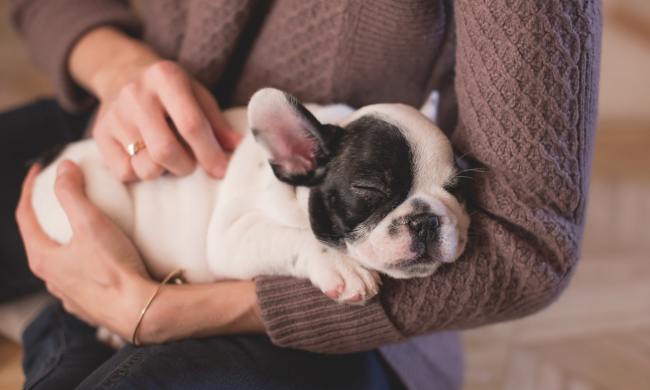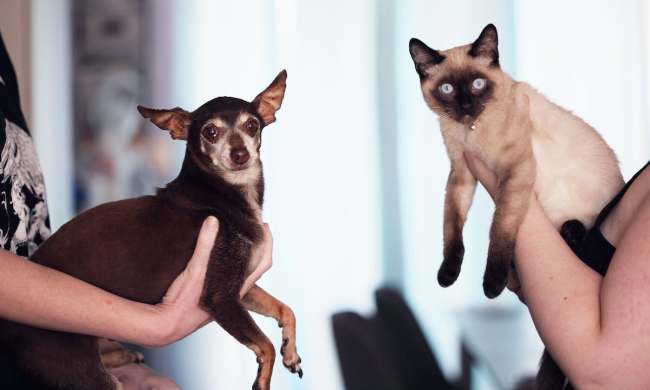You may find yourself rubbing your dog’s tummy one day and wondering, “Do dogs have belly buttons?” It’s true that you won’t see anything like our navel on your pup, but that doesn’t mean the belly button isn’t there. In fact, all placental mammals have belly buttons (meaning you won’t find them on a kangaroo or a platypus), and that includes our puppers. While in day-to-day life you don’t need to think much about your dog’s belly button, you should have some idea of where it is and what it’s supposed to look like in case something ever goes wrong down the line.
What does a dog’s belly button look like?

When a wolf gives birth to a litter of puppies in the wild, she chews the cords off shortly after delivery. Usually when our pets have babies, a vet or experienced breeder will cut them and give the newborns a quick check-up before returning to mom to nurse (of course, some dogs take care of this themselves, too). A few days later, the remainder will just shrivel up and fall off on its own. Behind this, they’ll have a permanent flat scar, which generally causes no harm or discomfort (we’ll cover later when it’s an issue).
Dr. Scott of Barking Heads explains to Country Living, “Dogs have belly buttons just like humans, but vets describe them as the umbilicus. They develop in exactly the same way as in humans, where the placental cord attaching mum’s uterus to puppy cuts and then withers away after birth.”
A pooch belly button will be a lot easier to miss than a human one, but you should be able to spot it if you give your dog’s abdomen a close look. Try running your hand along this area and feeling for it to help you locate the little nub.
Why can’t I find my dog’s belly button?

As a puppy, you will probably find the area pretty easily, but when Fido grows up, it might all but disappear. Sometimes, enough fur grows in the area that it’s completely covered, especially for beasties with long hair. Unlike in humans, dogs don’t have a noticeable innie or outie, which is part of the reason we have trouble recognizing this little slit for what it is.
If you do feel a protrusion, take a closer look and reach out to your vet right away. That could mean that your dog has a medical issue.
What’s an umbilical hernia?

Complications with the belly button typically mean an umbilical hernia, although, there are other things that can arise. Occasionally, a strange-looking umbilicus can happen because of an abscess. A brand-new baby could also get a bacterial infection in the first couple of days of life that would require a check-up. For other young puppies, it indicates that their muscles didn’t close properly, and the vet will have to do an exam to determine any underlying problems. But for the most part, this little bump means an umbilical hernia, which happens when your dog’s innards push through their abdominal wall.
Most likely, something else is going on underneath the hood, like the muscle weakness we mentioned earlier. Your vet will want to take action and may recommend surgery to repair the issue quickly. However, the condition does sometimes go away on its own, and in puppies, some dog doctors will wait until the animal is a touch older to operate. Many vets combine belly button surgery with a spay or neuter procedure so that your pup only has to go under once.
Certain breeds have this condition ailment much more frequently, including Airedale terriers, Basenjis, beagles, and Pekingese. For these buds, make sure to keep an eye on their little bellies in the first weeks and months of life so that you discover the hernia as soon as possible and know to monitor it, along with an expert.
Final thoughts

Dogs, like almost all other mammals have a belly button, which occurs any time an animal gestated in a uterus with a placenta. While our human navels are easy to notice, you would be forgiven for missing it on your pup since the small scar lays almost entirely flat.
Any time you do see a recognizable bump there, it’s time to take action, as that can indicate an issue, usually an umbilical hernia. Otherwise, you will mostly ignore your pet’s umbilicus if you happen to discover it as you pet your dog. Luckily, the tiny slit doesn’t decrease their love of belly rubs or gentle pats.




